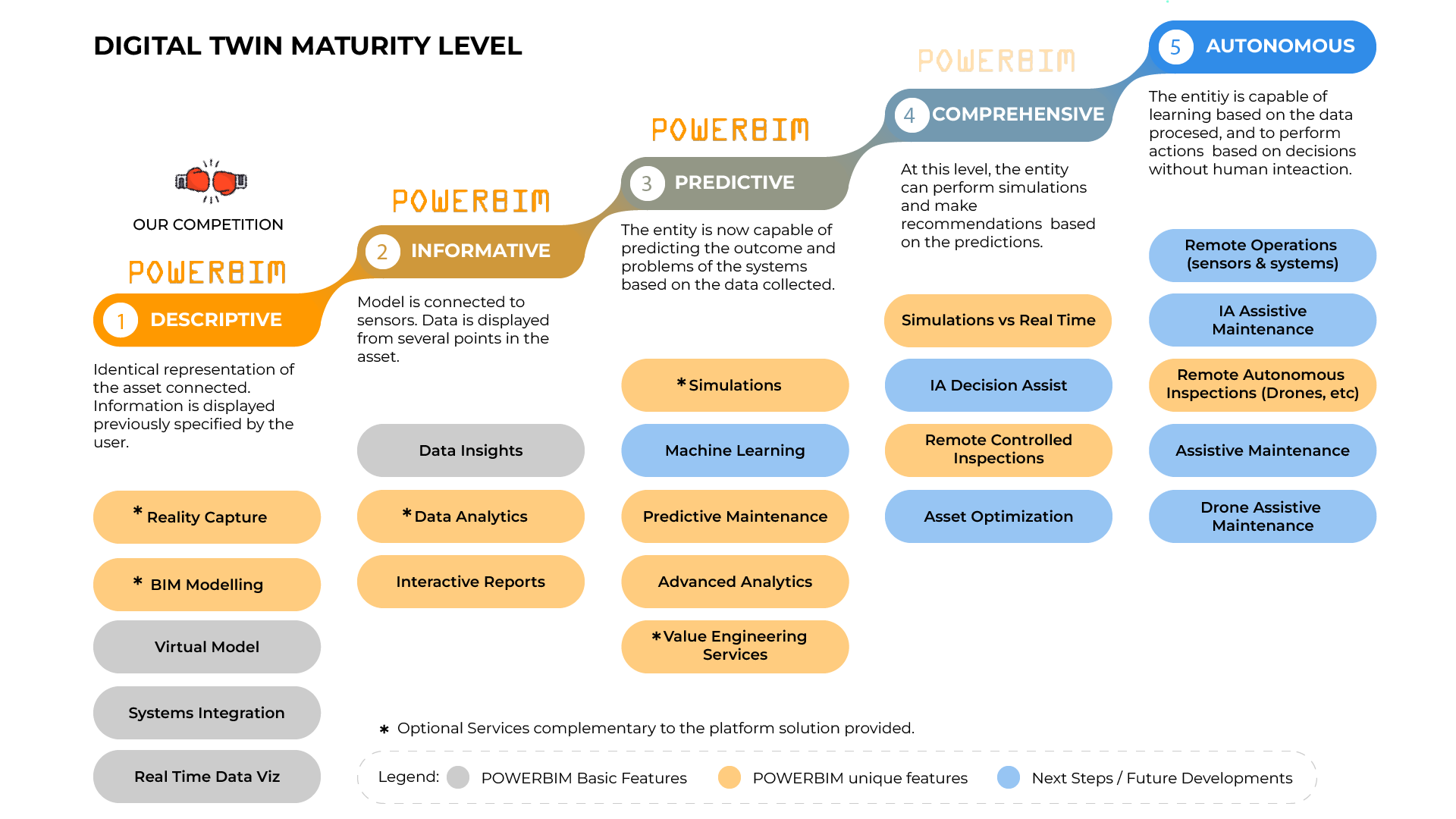Empowering the Future: Navigating the Landscape of Digital Twin Maturity with POWERBIM
Author: Fernando Morales
In this exploration of digital twin maturity, our journey with POWERBIM unfolds as a testament to the evolving landscape of technology.Positioned at the forefront, we transcend industry expectations, harnessing a unique blend of cutting-edge functionalities. From automated audits to real-time simulations, our platform pioneers the integration of vital dimensions, offering a comprehensive solution poised to shape the future of digital twins in our sector.
With a focus on the nuanced interplay of gray and orange facets shown in the infographic, we strive not only to meet but exceed the evolving needs, providing a robust foundation for the next era of digital twin innovation.
DIGITALTWIN MATURITY FOR BUILDINGS, INFRASTRUCTURES AND CITIES
The chart below aims to explore the technological maturity level of digitaltwin development, so that we have a classification capability for solutions that are currently presented as digital twins.
I have conducted this analysis based on various sources discussing the concept, while also contributing my own perspective that applies to the management of buildings, infrastructure, and cities – assets for which our POWERBIM platform provides a digital ecosystem-based solution.
I believe that this type of analysis, while there is not yet a standard definition, is necessary for various reasons:
- By defining the maturity level of a solution labeled as a digitaltwin, we will clearly determine whether this solution provides technological value for the objectives that the digitaltwin is supposed to have.
- A digitaltwin is an ecosystem of integrated technologies that should automate processes for specific use cases. Depending on the technologies that a solution can integrate, the solution is more or less mature.
- There are no two identical digitaltwin solutions, and there is much confusion about it because simply saying “digitaltwin” is not very informative. I believe that we should start classifying these solutions based on certain aspects. The chart below may be somewhat general, but it allows for positioning solutions as either less mature or highly mature.

The chart displays colors in the cells, and these colors represent three types of technologies/services that digital twins should include, based on our vision and experience with POWERBIM, as well as the analysis of the competition:
- Gray: Represents technologies or services that are assumed to be minimal or foundational for a digitaltwin, present in almost all platforms self-identified as digital twins, typically in a less mature or preliminary state.
- Orange: Moving into our sector, these represent technologies or services that a mature digital twin should have. This is essential for considering a solution as truly mature and capable of deploying a range of use cases that contribute real value.
POWERBIM incorporates functionalities and services for all the elements marked in gray and orange in a unique way, with little competition. Beyond integrating or visualizing data, the digital twin should be used to solve process problems, and for that, we need to be able to generate advanced analytics and simulations.
- Blue: Represents functionalities or processes that should be incorporated from today into the nearest future to be able to talk about the autonomous digital twin. This involves incorporating artificial intelligence as just another service available for use cases. The aim is to autonomously determine the best arrangement of variables based on simulations to solve complex problems more efficiently than a human team. It should be capable of acting on systems with critical failures, transmitting results, communicating in natural language with operators, or even controlling devices such as rovers, drones, mechanical arms, and perhaps not too distant in the future, fully functional robots.
The future of digitaltwins is promising, and each sector will need to address its evolution differently, but with common aspects related to how artificial intelligence will convey information to humans and the actions it can exert on the systems it controls.
Going upstairs to achieve fully matured digitaltwins, POWERBIM is positioned in the middle of the journey, surpassing solutions that are presumed to be highly advanced from major technological entities. With our five years of development, we understand that the digitaltwin has much more room to evolve. However, in our case, with the current integrated technologies applied correctly, we can already enhance and optimize the primary use cases that we classify according to the so-called BIM dimensions:
1D – Automated audit and compliance with standards/regulations
2D – Document management, integration of documents and files linked to assets
3D – Analytics of static data derived from the digital model (BIM/GIS)
4D – Management of temporal processes (planning, warranties, etc.)
5D – Integrated management of measurements and budgets within the digital twin
6D – Simulations, real-time data from integrated management systems, machine learning, and predictive analysis
Final reflections
This chart is not an exhaustive study that incorporates all aspects to consider for the development of a mature digital twin in our sector. It is merely a general approach and requires further development to delve into the details, perhaps necessary to create, as an objective, a specific list of requirements that the digital twin for our sector should have. However, in our case, with the POWERBIM platform, we believe that the gray and orange cells, with all the nuances we may consider, provide a substantial approximation.